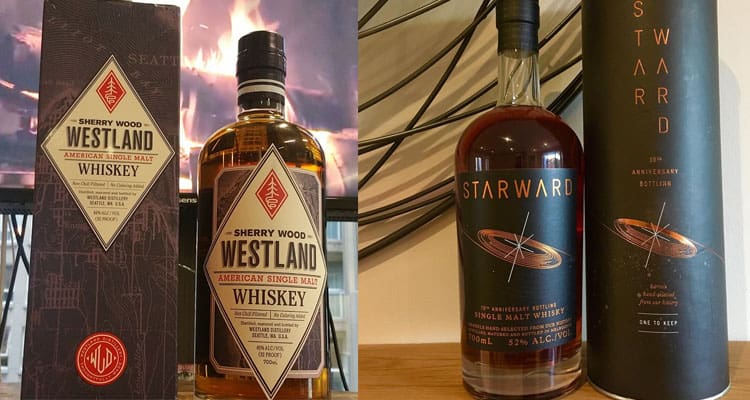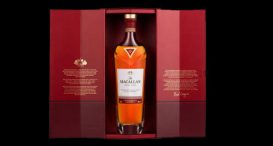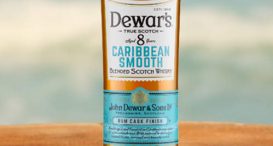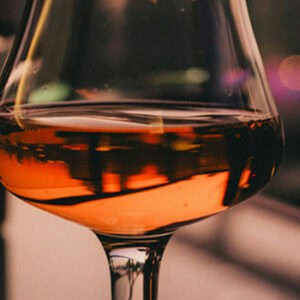Malt Beyond Scotland. Reviews of Westland and Starward American Single Whiskey
let’s begin
I love Single Malt Scotch Whisky. If you’re reading this, then I expect you do too – or at least know someone who does. If not, this may not be the website for you...
Thing is, incredible Single Malt is made all around the world now. Japan’s probably the next most famous these days – just wish I could actually afford any of it. But then you’ve Kavalan in Taiwan, Amrut in India, Mackmyra in Sweden, etc etc ad infinitum.
Which is absolutely wonderful news as far as I’m concerned, and today I’m going to be reviewing two of them. Squaring up on opposite sides of the Pacific, separated by well over 8000 miles of water, we have Seattle’s Westland American Oak and Melbourne’s Starward. (OK, I know Melbourne isn’t technically on the Pacific, but you get my drift. It’s in the way, in any event, so far as travellers are concerned.)
We’ll kick off with Westland, as there’s been a buzz around them lately in the wake of their purchase by Remy Cointreau, who also own Islay’s Bruichladdich.
I happen to think this is rather a good fit; like Bruichladdich, Westland do things a little differently. I think Remy Cointreau will embrace that, whilst hopefully increasing its presence worldwide. Remains to be seen, of course, but I’m staying optimistic.
How do they do things differently then? Well let’s start with the malts. If you look on their website – and you should, it’s unusually informative – you’ll discover that they use five. Washington Select Pale Malt, Munich Malt, Extra Special Malt (I’m not sure, either), Pale Chocolate Malt and Brown Malt.
I’m not a beer drinker, which I know is an odd confession for a whisk(e)y geek, but to me that adds up to a lot of thought in the brewing process. Which should be absolutely fundamental to whisk(e)y making. Surely the more interesting the wash, the more characterful the distillate?
They also specify their yeast strain – Belgian Brewer’s – and the rather long fermentation time of 144 hours. Spirit is housed primarily in new oak, with a few ex-bourbon casks for good measure.
Which poses some intriguing questions for malt lovers such as myself. Primarily, what flavours are each of those malts bringing to the table? Are they mashed together or separately? (Surely together?) What influence do the ex-Bourbon casks have beside the far more assertive virgin oak barrels?
All in all, this is a Single Malt which I would be fascinated to taste in its constituent parts; to experience those five malts separately and then as a unified whole. To taste a sample without the influence of new oak, and then without the influence of ex-bourbon. Before I’ve even opened my bottle I find myself drawn in – not by marketing story or some bizarre finish or other, but by genuine whiskey interest. Which I think is pretty great.
One last aside, before I crack on with the actual tasting. The website states that the whiskey’s age is a “minimum of 24 months.” In Scotland, of course, that would mean it wasn’t legally whisk(e)y at all, but of course evaporation and extraction rates are different in America. Not to mention legislation.
It does make me wonder whether £65 per bottle is slightly high though. I do understand that Westland is quite a small enterprise, but when you consider the quality of many American whiskies under £50 a throw – Baker’s 7, Woodford Double Oak, Elijah Craig 12 etc – a £65 price tag demands quite a lot.
Anyhow. To business.
Westland American Oak Single Malt Whiskey – An intense, piercing, and startlingly pure nose. All about the high notes; there’s dark chocolate (also chocolate stout – thanks Liv!) – but beside that there’s a touch of menthol and blackcurrant. The sort of aromas you might find on youngish New World Cabernets. Sweet; those new oak casks doing their usual caramel and vanilla thing – but not cloying, thanks to that purity and youthful lift.
Palate tells a similar story, although the flavours become a little more unctuous as vanillas and sugar crash in on top of the chocolate and fruit. Surprisingly viscous – really sticks to your teeth, but that’s sugars, not tannin. The alcohol keeps things clean, fresh and lively – though it’s not fiery, as the intensity of flavour and weight of body maintain balance. Oak influences, but this spirit isn’t especially ‘woody’. Suspect those five malts are making rather a lot of difference. Long finish. 46% ABV.
Interesting, different and very tasty indeed. First encountered this back at the Whisky Show in October, and was sufficiently impressed to make a rare foray over my usual £50 per bottle limit.
Yes, it’s not especially old, but there’s enough character from malt and oak to keep the youthfulness in check. If anything, it adds a refreshing vibrancy. I think it’s cracking. Seattle clearly knows its way around a tun and a still. But what else would you expect of Frasier’s hometown?
On which note, we’ll sail across the Pacific for a peek at Melbourne’s Starward.
I don’t usually comment on packaging, but when I unwrapped my bottle of Starward all the designers in my office gathered round, cooing in a complimentary tone. It’s also only one letter and a space away from being Star Wars, so that’s my pour sorted for 4th May.
“New World Whisky Distillery” proclaims the label, which goes some way to explaining the name. It’s aged in Apera casks, which is what Australians call their Sherry-style fortified wine, in lieu of being allowed to call it Sherry. I’m a big fan of sherried malts, so I was intrigued to try an Apera-aged expression.
I put off buying and trying Starward for a while though. My reason was a stupid one – and if Whiskylassie reads this she will quite rightly say “Hah!” Very simply I couldn’t understand why Starward was being sold so much cheaper than any other Australian whisky currently retailing in the UK.
Not really having heard anything about it beforehand, I was slightly nervous to spend £46, when the next cheapest I could find was in the region of £80 a throw. Somehow it raised alarm-bells, and I wondered whether the reason was rooted somewhere in the quality.
So on finally tasting it last year, I was surprised – and thrilled – to discover that I loved Starward (spoilers). Better still, I had a good chat with the chaps behind the stall at the Whisky Show, who were the friendliest people I met there. (And that’s a massive statement.)
The upshot was that I bought myself a bottle last month, and here for your consideration, are my notes:
Starward New World Malt Whisky – Despite the low strength, there’s a chewy robustness to this whisky that put me straight in mind of the Scottish Highlands. The Apera presence is clear, but not swamping. There’s red fruit, chewy malt and a slight hint of nutty, oxidative character on the nose. For some reason I’m put in mind of pink wafers too – and that’s not the first time I’ve thought that about Starward! Some baked apple, caramel and a touch of sultana contribute to a nice brooding depth.
Viscous and grippy; there’s a lot of natural sugar from the casks, and the Apera has contributed to an unctuous, almost sticky mouthfeel. Wonder whether the Apera was closer to PX or Oloroso in style? More of the fruit, but there’s a touch of burly meatiness. Certainly a deep-flavoured whisky – ‘Autumnal’ for me – but there’s enough zip from the alcohol to prevent it from becoming flat or cloying, and to remind you that this is still technically a young whisky. 43%ABV
Starward has been one of those whiskies that just sticks in my head, and niggles at me. In a good way! I really can’t stop thinking about it. When I poured a glass for Will, my partner in tasting crime, he guessed something like Glenfarclas. And he loves Glenfarclas. I wouldn’t say it was exactly like any specific Scottish distillery – but that sense of the meatier, sherried Highlanders still won’t leave me alone.
I absolutely adore Starward. I think it’s worth every penny of £46, and my only regret is that I’ve already used so much of my bottle getting people to taste and experience it that soon I’ll have none left! Funnily enough, as you read this, I’ll be in the middle of my first ever Australia trip (probably getting mangled by some ghastly animal or other) and I’m gutted that I won’t have the chance to visit them in Melbourne.

But how do I think the two compare?
Well, I don’t. There’s no point. They’re about as far apart in terms of flavour as it is possible for two unpeated Single Malts to be. Where Westland is about the high notes, Starward brings the bass. Westland is (mostly) virgin American oak, Starward is ex-Apera.
But both were unquestionably amongst my favourite discoveries of last year, and I can’t wait to try further offerings from each distillery. The only thing that splits them in my preferences is the price. Westland is £20 more expensive than Starward, and I’m afraid that doesn’t quite stack up in terms of quality.
But then the ex-Apera/Sherry style isn’t for everyone. My bourbon-obsessive friends would be far happier with the Westland than with the Aussie. I suspect my Scotch-focussed father and uncle would lean more towards the Starward.
We’re drifting into the realms of subjective there, so it’s time to draw a line. The point is this: the brave New World of Single Malt really does have something for every palate. And whilst that’s hardly big news, I wonder how many UK-based whisk(e)y drinkers are fully taking advantage?
On this evidence, they should be.
Cheers!














